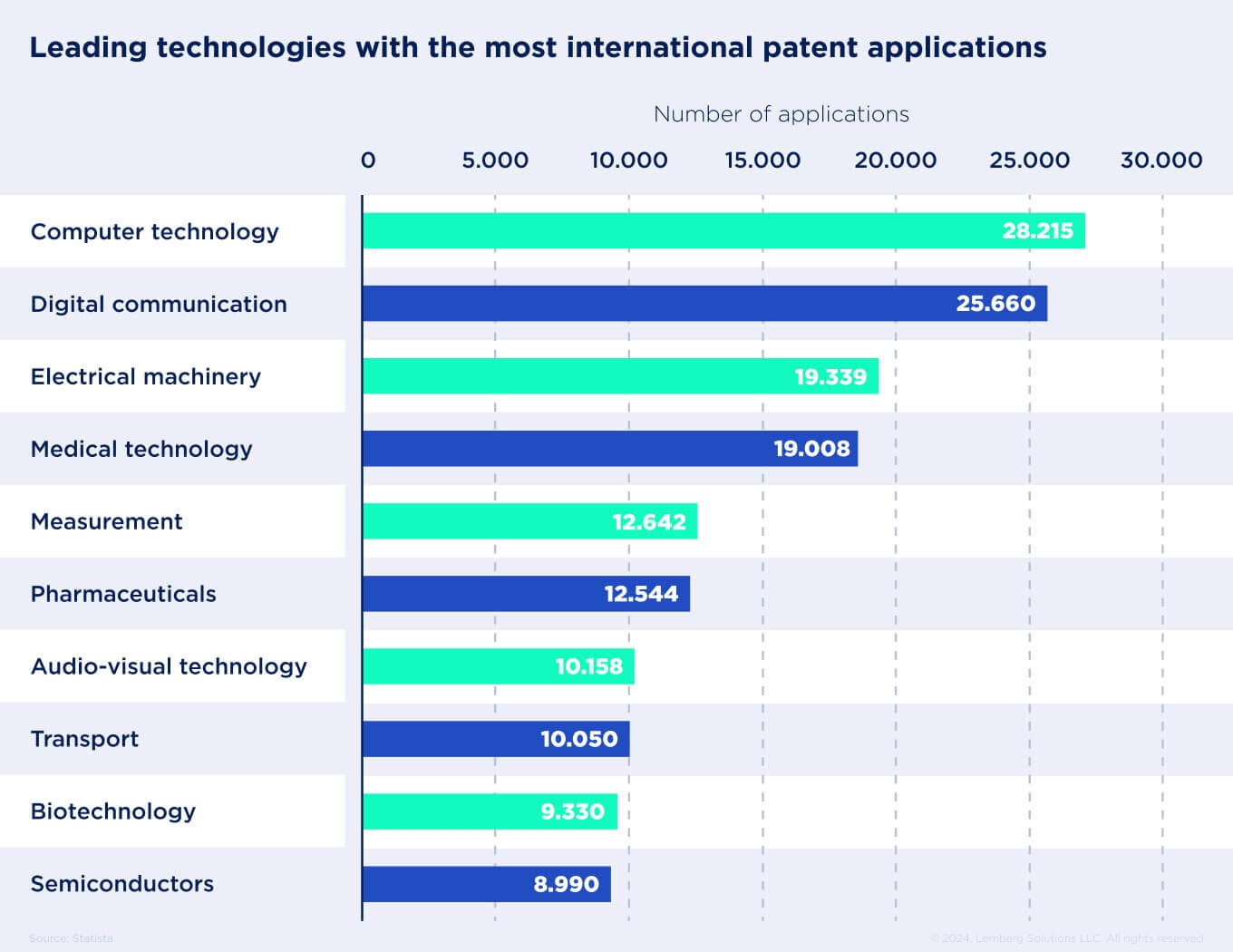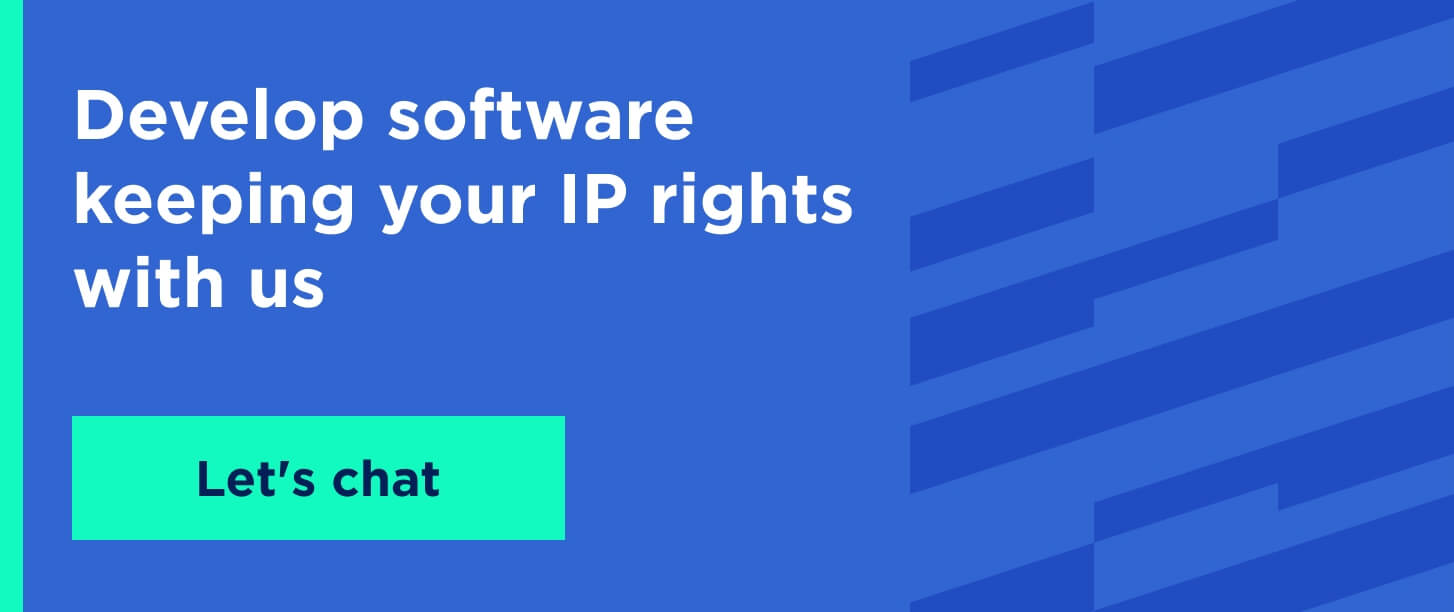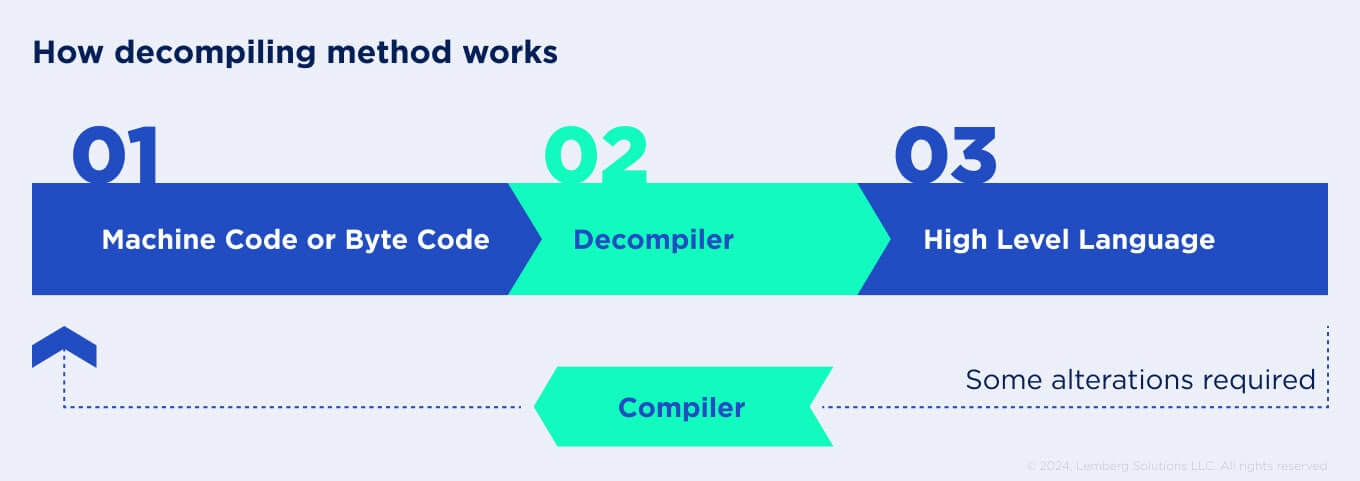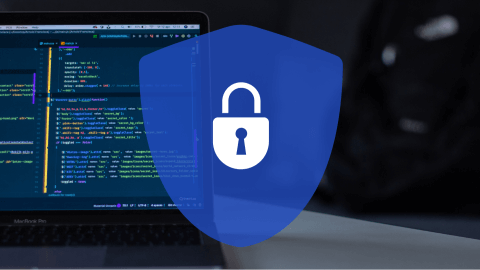In the era of rapid technological evolution, software intellectual property protection has become a top priority because of the simplicity of information distribution and increasing vulnerability. You might not consider software IP important when you only come up with a future product idea. Nevertheless, reflecting on software intellectual property protection strategy from the beginning of the software development process is vital.
Our article researches the specifics and types of intellectual property protection for software products. We also share how Lemberg Solutions ensures software IP protection and what approach we follow to help you recover previously lost source files.
What is software intellectual property?
Before diving into the specifics of intellectual property protection for software, let's define what intellectual property means and its differentiators for software products.
Intellectual property is an intangible, unique creation used as your business asset. Among the categories that relate to intellectual property are brand names, inventions, published content, including text and visuals, software and all its components, and other business-related original information.
Software intellectual property entails a computer program or code that cannot be copied, stolen, or used for any other purpose without the owner's permission.
Whether your internal engineering team creates a software product from scratch or you outsource the software development to a tech partner – it's your business`s intellectual property, including all project documentation and source files. After completing the development process, you must receive all rights and access to the software files.
Once your software is released, it can be attributed to certain IP types, but some must be registered. We outline what IP categories exist, how to define your software classification, and how to register software for your intellectual property.
What are software intellectual property rights?
Software intellectual property has the same IP rights as any other type of unique creation. These include copyrights, design rights, trademarks, and patents.
All these rights are valid if your solution was explicitly for your business purpose. If you deliver or use open-source software, then the relevant software IP right is copyleft. It allows you and other users to copy software and use it for your points, but you still need a license.
Further, we will look closer at the types of software intellectual property and how they can be protected.
Top 5 categories of software intellectual property
Five main IP types will help you protect your software, including its source files, whether it is a standalone solution or a part of functionality integrated into a full-fledged product.

1. Copyrights
Copyright protects not the idea of your software but the way this type of software is interpreted and used. It means your solution may not be an actual invention, but you still can register a copyright to protect your software source files from being copied and used by other developers. In the case of software copyright infringement, you have all the rights to sue with violators.
2. Design rights
Design rights apply to the physical characteristics of product design, where software can be an embedded part. If a law protects design rights from copying, you can register your product design at your local public institution. Once your product design is registered, others can be prevented from duplicating its elements and overall concept for a certain period.
3. Trademarks
Trademarks guarantee your software source files will be protected from being copied or used by other companies without your permission for 10 years. This type of IP also safeguards your brand attributes, including logo, promo, brand name, symbols, and other components. Regarding software trademarks, it may include the software name, attributes, functionality, and usage purpose within your business.
4. Patents
Receiving a patent is a multi-step process requiring your software to comply with various requirements. The requirements, though, differ depending on the industry and country.What makes obtaining a patent more complex than other computer software intellectual property types is invention. It means your software must be unique and a real breakthrough in a technology that hasn't been seen in the market before.
As you can see from the statistics below, computer technology has taken the first place in business assets that have been registered as patents.

Nevertheless, the patent only lasts for a while. On average, your software functionality is considered an invention for 20 years. Afterward, you can file for patent renewal if your software remains an invention in the area.
5. Open-source software
If you launch open-source software or use one for your business needs, consider the copyleft approach. Copyright defines your software as intellectual property and forbids unauthorized access to its documentation, source code files, copying functionality, or use of any related information.
Copyleft legally allows you or other users to copy and adjust the software documentation and functionality if such software is publicly available or open-source. Nevertheless, you still need to get a copyleft license from the software owner to alter its operation as you require it.
Why intellectual property is essential for your business
Protecting your software as intellectual property benefits your business from different aspects. Whether you want the software to manage your business processes and customers or a SaaS solution for sale, IP protection adds trust and value to your business, keeping up with the competition. Also, it helps you prevent or mitigate risks related to copying and stealing your computer program, its functionality, and its code.
Another considerable advantage of software IP protection is access to the solution source code and original documentation, even though you may switch to other tech partners. It guarantees you can easily transfer all information about your software product, its logic and functionality, and the tech stack used and proceed with the development or maintenance with another engineering team.

How can software be protected as intellectual property?
You should ensure your software intellectual property is protected from the outset of your cooperation with a technology vendor. IP rights for software come into force at the idea elaboration stage. Moreover, you and your tech partner have to outline the cooperation conditions and sign contracts like non-disclosure agreements that protect you and your intellectual property throughout the whole process.
Below, you can get acquainted with software intellectual property rights agreements you should consider creating, approving, and signing before the development process starts.

Confidentiality agreement
A non-disclosure agreement is a primary confidentiality document you must sign with a software development partner. There are different types of such contracts, but all of them focus on your conditions. This document defines each team member's level of involvement, describes how project data can be used, and lists who has access to it, including source files.
IP assignment agreement
Another document you should consider signing with your tech partner is IP assignment. This agreement outlines that all data, documents, and source files belong to your company from the outset. It helps avoid misunderstandings during cooperation and guarantees you receive the full software documentation after release. The engineering team cannot keep it or use it for another project.
File for registering your software as IP
To enhance your software IP rights protection, you should also file for registering the solution under one of the categories mentioned above in the article. Based on your software purpose and functionality, it can be registered as a copyright, trademark, or patent. More details about your case can be learned from the official representatives in your country, as what can be patented in the USA is not applicable for a patent in the UK, for instance.
You can agree on the documents and their content individually with the engineering company you have selected. The only condition that matters is to legally ratify the signed contracts so that the software IP law can come into effect.
At Lemberg Solutions, we adhere to the ISO/IEC 27001:2013 requirements to ensure secure cooperation, where signing a project NDA is a must-have. We also have precisely defined roles on projects, where only authorized users can access the project documentation and source code.
What problems can arise with software intellectual property?
Suppose you are not an early-stage startup anymore. You've got some investments and new opportunities. It's time to move forward and start improving your product by adding new features and technologies. You just hired engineers to work on your product in-house because you need to move fast now, and you want to have complete control of how your product will evolve.
The problem is that you previously asked a low-cost development company to make the prototype for you, and they still need to provide the IP. You don't have the source files to modify, and you are tied to this vendor, which can now claim its terms.
That's a common problem for many companies trying to save as much money as possible on the PoC phase. Your product enclosure will likely regain all the source code, schematics, PCB, and 3D model files.
How we can help to protect your software IP
In contrast to the company you worked with before, we provide the full IP once the full payment is provided. Whether we develop a product from scratch or restore the source files of your existing product, you get ownership of all project documentation.
Decompiling
The easiest way to get the source code from a compiled binary file is by decompiling it. The primary purpose of decompiling is to reverse engineer the software solution and interpret it into a high-level programming language. It helps engineers discover how the software works and its functionality to restore source files.
Indeed, software code deviations from the original files are always probable as decompilers restore a particular part of the code. However, you still save much development time as you don't have to build the same solution from scratch but rebuild it based on the input data.

Once the decompilation is complete, we can refactor the code to improve its performance, reduce the binary size, and make it compatible with new hardware.
Nevertheless, decompiling can be executed only if the binary has not been encrypted or protected from scanning and copying.
Development by product reference
In most cases, the binary is encrypted or protected from scanning, and decompiling is impossible. In this case, we will make the code from scratch but use the existing firmware or software and its description as a reference. This will allow us to save time developing business logic and avoid spending time on the requirements agreement.
Reverse engineering
We are using reverse engineering for recreating the electrical schematics and PCB tracing. To say a few more words about reverse or back engineering, this is the process of producing electrical schematics and PCB deconstruction to discover its initial architectural design and interpret it in readable language. This is a beneficial method when you have lost access to your product source files, so we take on its investigation.
As with the software, we provide recommendations on improvements and can implement them at once. These include miniaturization, replacing obsolete or inefficient components, reducing heat generation, and optimizing power consumption.
Summing up
Considering the vulnerabilities that may affect your software intellectual property, you see how important it is to collaborate with a reliable tech partner for your software development, not only in words.
Before signing the cooperation contract, discover what additional documents you can sign to protect your software IP. These can be non-disclosure agreements, IP assignment agreements, and so on. You can also file to register your software as IP at the local government institution.
At Lemberg Solutions, we guarantee your software is protected and assigned to you as the only owner, whether we do it from scratch or restore the source files of an existing solution. If you have any additional questions about how we ensure your software IP protection or need assistance restoring the software product source files, don't hesitate to contact our experts and discuss everything you are curious about.




